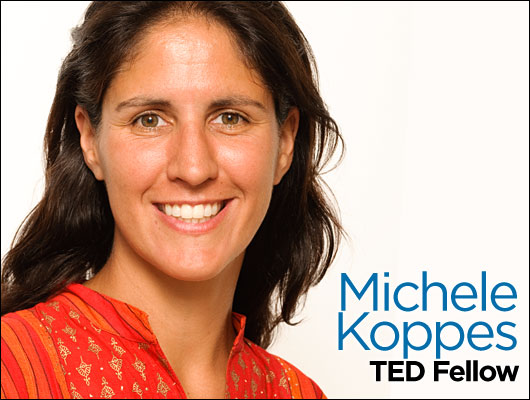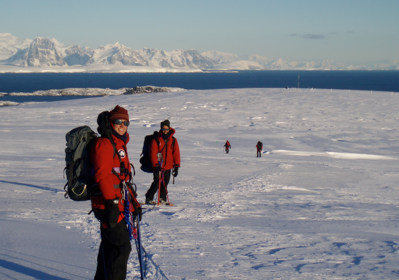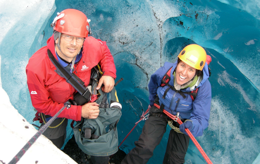Glaciologist Michele Koppes travels to some of the coldest, iciest places on Earth for work. Her one-of-a-kind research in the Himalayas fills in gaps of unrecorded glacial change, and may help vulnerable populations adapt to shifting weather patterns. Despite the severe consequences of climate change, Michele finds hope in the optimism of the younger generation, and the growing role women have in tackling this (and other) global issues.
Interactive Fellows Friday Feature!
Join the conversation by answering Fellows’ weekly questions via Facebook. This week, Michele asks:
Is there a unique role that women can play in fighting climate change?
Click here to respond!
For you, both research and communication are important for addressing climate change. How do you use your expertise for these two goals?
I’m a university professor, so I spend about half my year teaching courses about physical geography, field techniques, snow and ice processes, and climate change to undergraduates. The other half is spent planning, fundraising and coordinating field research campaigns to far-flung, remote regions, such as the Northwest Himalayas, Greenland, southern Patagonia and Antarctica. In between, (often on flights between these crazy places), I try to write up all our research findings for publication!
I’ve founded several novel experiential education courses for underrepresented groups that combine earth science and outdoor leadership skills. One was a glaciology course targeting young women, and another was environmental awareness and conservation courses for inner city youth. Although I’ve passed the torch on those particular projects, I believe strongly in experiential education, and incorporate hands-on learning in my courses.
I was also privileged to be a science policy fellow in the US Congress. I work to bridge the gap between the scientific research community, policymakers and the media.
Tell us about your glacial research project in the Himalayas.
All of these major rivers in the region — the Indus, the Ganges, the Brahmaputra — are fed by glaciers, in their upper watersheds. But there have been very few studies on changes in water resources in the upper parts of the Himalayas. One group, however, has monitored a glacier on the monsoon side of the Himalayas for the past two decades.
So in 2009, we went out and found a similar type of glacier on the back side of the Himalayas, which is not affected by the monsoon. We set up the instrumentation and did the preliminary base study. We began to measure the relationship between temperature, air, solar radiation, and melting of the ice.
We’re trying to see how much change we’ve already encountered in terms of these glaciers. We can do this by using the sediment record, or the geomorphology, around the glaciers. We can see where the glacier was recently, how much it has pulled back, and how much it has thinned. We also have satellite imagery that goes back to 1979, and we can estimate the change with that. We’re trying to model what’s happening to these glaciers in terms of the climate.
How will your work directly affect the people of the Himalayan region?
We’re trying to establish a process and a network in which we include local stakeholders. For instance, I was also working in the Miyar Valley in the Himalayas. Theirs is an agrarian culture, and they have been there for several hundred years. The people live on big mountains with lots of steep slopes, so they built these open water systems, or irrigation ditches — some of which are hundreds of years old — that they pull straight out of the glacial mountain streams. There’s very little precipitation in this part of the world, so the glaciers provide much of the water for irrigation, particularly in the non-monsoon months. This is the major potato growing region of India, and potatoes require a lot of water, particularly close to harvest time.
People are seeing a change in the total amount of water coming out of the glaciers, and the timing of that. It’s getting very hard to determine, at the beginning of your growing season, what’s going to happen later in the season, when the snowmelt is going to occur, or when you should start your planting. Imagine what a failed aloo crop would do to Indian cuisine!
So we have been coordinating with some colleagues in India, trying to talk to the people in these valleys who have the first-hand accounts of what changes they’re seeing, and trying to record that, so we can create a history of climate change in the area. We’re also helping set up a system where we go and get information about what’s happening to the glaciers and how they’re melting, and make these anticipations. And then we relay that back to these communities so they can work with that information.
In other countries, in other mountain ranges in the world, these types of studies have been going on for fifty years. So we have a very good base level to make inferences about what’s going to happen in the future in the Himalayas.
How have similar studies been used to help people?
Where I live in the Pacific Northwest, in the US and Canada, in 1957 they established a number of reference glaciers. The record created has been used by the hydropower generating plants in this area. Hydropower creates ninety percent of the electricity of the city of Seattle. In order for the city officials to make good estimates of how to run their reservoirs — when they have to lower their reservoirs, and how much they expect to fill them up so that they can have power throughout the summer season — they use estimates of snow cover and glacier melt from April 1st.
What we’ve noticed from looking at these mass balance studies of the glaciers is that snowmelt has occurred earlier in the year. Every decade the timing of the loss of snow is occurring earlier in the year, and there’s been less snow coverage.
We’ve also noticed regional differences across the U.S. The Southwest is getting drier, for example, and the Northwest and the Northeast are getting wetter.
Most of the people find these reports of climate change pretty scary.
Yes, in most of the world, apart from the US, people have accepted that things are changing. They’ve noticed the change, they’re a little scared of the change … in many places they’ve been able to adapt to that change.
What I’m scared about — I’m scared, too — is that the pace of the change has been increasing. Over the past two decades, there’s been a big influx of new information about sea level rise, temperatures in the ocean, temperatures on the land, storminess, and the development of typhoons, monsoons and hurricanes.
As I mentioned, I do a lot of work on glaciers in Greenland and Patagonia, where the ice is responding really rapidly to changes. We’re seeing a pace of change that hasn’t been recorded before. And so it’s a question of, “How are people going to adapt to that change? Particularly the most vulnerable people?” The people that are living in the floodplains of these rivers, for example. Are they able to adapt to the change?
There are places that have a lot of resilience, and there are places that have very little resilience, where you have people pushed up against the edge of the climate boundary. People, for example, that are moving their way up the mountainside, and there’s nowhere else to go because there’s no soil above there. How will they adapt to that aspect?
Is there reason for hope in the face of climate change?
Yeah, it’s amazing. I’m a professor at the University of British Columbia and the students that are coming in now have a much broader sense of the world as a whole. They have a lot more optimism that through information transfer — which is at their fingertips — change and adaptation will happen. They really believe it. And if you believe it, you can make it happen. I think there’s a little more cynicism in the older generation.
The people who are coming in to school now are also looking across disciplines. A lot of students don’t just want to know how to track climate change. They want to know what that means for people, and how people are going to need to respond. And they want to make their science or whatever they do, socially relevant. I do see a lot of optimism in the younger generation that we can actually figure this out.
There are many aspiring social entrepreneurs out there who are trying to take their passion and ideas to the next level. What is one piece of advice you would give to them based on your own experiences and successes? Learn more about how to become a great social entrepreneur from all of the TED Fellows on the Case Foundation blog.
My husband is an investor who supports social entrepreneurs serving the base of the pyramid. A few years ago, I joined him as he visited a microfinance institution in rural Karnataka. The one thing that I learned from this experience is that everybody has great ideas. If you just give people the tools to test their ideas out, they’re going to make the best decisions for themselves.
So what I would say to anybody who wants to be a social entrepreneur, is just to believe in yourself. Go for it, and do it! And talk it out to people. Talk it out to people you think would respond favorably, and hopefully they will figure out ways to help you to get the capital to get going. Once it starts going, it can be a real snowball. But you just have to have faith that you’re able to do it.
Also, be realistic about what your strengths are, and where you could use help. Seek help where you could use it. Being an entrepreneur is a really hard thing. There are many, many people with many good ideas, but a person who’s able to do all the different aspects of starting and running a business are very few and far between. Knowing your strengths and knowing your weaknesses, and seeing where you can get help where somebody else has a strength, is the best kind of partnership to get an idea off the ground.
You’ve said that you find your spiritual center through your work.
I really find solace in the mountains, in the big places … sometimes in the places where humans aren’t normally meant to be. I’ve done field work down in Antarctica, where we sat in a tent on an ice sheet for three months. And it was flat … and white … and cold. It was an amazing way to be able to really connect with yourself, because there are no other external forces. And to recognize that you’re a guest in this landscape: there’s no way that you could be here in the long term, without this whole support network that you’ve set up.
That feeling of being an ant on the face of this beautiful system, the Earth, is a very spiritually uplifting thing to me. Maybe to others it wouldn’t be. I love to hike in the mountains, I love to visit the deserts. It ends up being a walking meditation when you’re out there. And sometimes it’s a very harsh climate. It’s an environment to seek within oneself, to slow down. It’s harsh, you have to survive, you learn what you’re capable of.
It’s a beautiful thing that I managed to find a career where I can go to these places and it’s actually work, and I can also be in a place where I feel grounded.
How has the TED Fellowship affected your life?
Going to the TEDIndia conference was very uplifting. It was eye-opening to me to see how many people are so focused on betterment of the world. The vast majority of the TEDIndia Fellows were social entrepreneurs, very keyed in, with hugely open hearts, to try and figure out how to make other people’s lives better. I was inspired by this idea of how to take the science that I’m doing, and make it socially relevant to all people.
So I’m trying to be more engaged in terms of communication, the science that I do, and how I build new research programs that deal with the vulnerable populations.
You attended TEDWomen in Washington, D.C last month. What were your impressions of the conference?
The TEDWomen conference really confirmed for me that a dialogue about women and girls in the workforce, in public life, and in private life is still needed, even 100 years after suffrage in the US. The equality of women, and the unique attributes that women bring to work, to family and to society, around the world, is going to be a sea change. But it is a slow change, and even in the Western world, in many parts of life it has yet to change the status quo. We need to support the ways in which women — more often than men — think and act. Women tend to think and act with compassion, with communication and with acceptance. Women more often are thinking about the other, not just about ourselves – and we should celebrate and reinforce these traits in the business and political spheres.
There were many successful, ambitious, passionate speakers on the TED stage at this conference. But the one aspect of all of them that really inspired me, was the amount of heart that they put into their work, and how that made real change.



Comments (6)
Pingback: What Do All These Women Have in Common? – PS11's H.O.P.
Pingback: Look Again , They all are Scientists !! – Khushboo Pandey
Pingback: Meet the 2016 class of TED Fellows and Senior Fellows - LifeSpace Connect
Pingback: The Biggest Game of Where’s Waldo | Matt Chernos
Pingback: Fellows Friday with Michele Koppes « TEDxMuscat